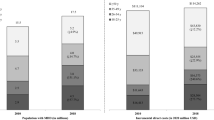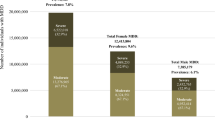Abstract
Purpose
Mental health is one of the priorities of the European Commission. Studies of the use and cost of mental health facilities are needed in order to improve the planning and efficiey of mental health resources. We analyze the patterns of mental health service use in multiple clinical settings to identify factors associated with high cost.
Subjects and methods
22,859 patients received psychiatric care in the catchment area of a Spanish hospital (2000–2004). They had 365,262 psychiatric consultations in multiple settings. Two groups were selected that generated 80% of total costs: the medium cost group (N = 4,212; 50% of costs), and the high cost group (N = 236; 30% of costs). Statistical analyses were performed using univariate and multivariate techniques. Significant variables in univariate analyses were introduced as independent variables in a logistic regression analysis using “high cost” (>7,263$) as dependent variable.
Results
Costs were not evenly distributed throughout the sample. 19.4% of patients generated 80% of costs. The variables associated with high cost were: age group 1 (0–14 years) at the first evaluation, permanent disability, and ICD-10 diagnoses: Organic, including symptomatic, mental disorders; Mental and behavioural disorders due to psychoactive substance use; Schizophrenia, schizotypal and delusional disorders; Behavioural syndromes associated with physiological disturbances and physical factors; External causes of morbidity and mortality; and Factors influencing health status and contact with health services.
Discussion
Mental healthcare costs were not evenly distributed throughout the patient population. The highest costs are associated with early onset of the mental disorder, permanent disability, organic mental disorders, substance-related disorders, psychotic disorders, and external factors that influence the health status and contact with health services or cause morbidity and mortality.
Conclusion
Variables related to psychiatric diagnoses and sociodemographic factors have influence on the cost of mental healthcare.
Similar content being viewed by others
References
Baca-Garcia E, Perez-Rodriguez MM, Basurte-Villamor I, Fernandez del Moral AL, Jimenez-Arriero MA, Gonzalez de Rivera JL, Saiz-Ruiz J, Oquendo MA (2007) Diagnostic stability of psychiatric disorders in clinical practice. Br J Psychiatry 190:210–216
Baca-Garcia E, Perez-Rodriguez MM, Basurte-Villamor I, Lopez-Castroman J, Fernandez Del Moral AL, Jimenez-Arriero MA, Gonzalez de Rivera JL, Saiz-Ruiz J, Leiva-Murillo JM, de Prado-Cumplido M, Santiago-Mozos R, Artes-Rodriguez A, Oquendo MA, de Leon J (2007) Diagnostic stability and evolution of bipolar disorder in clinical practice: a prospective cohort study. Acta Psychiatr Scand 115:473–480
Becker T, Kilian R (2006) Psychiatric services for people with severe mental illness across Western Europe: what can be generalized from current knowledge about differences in provision, costs and outcomes of mental health care? Acta Psychiatr Scand Suppl 429:9–16
Bourgeois JA, Kremen WS, Servis ME, Wegelin JA, Hales RE (2005) The impact of psychiatric diagnosis on length of stay in a university medical center in the managed care era. Psychosomatics 46:431–439
Carr VJ, Johnston PJ, Lewin TJ, Rajkumar S, Carter GL, Issakidis C (2003) Patterns of service use among persons with schizophrenia and other psychotic disorders. Psychiatric Serv 54:226–235
Desai MM, Rosenheck RA (2003) Trends in discharge disposition, mortality, and service use among long-stay psychiatric patients in the 1990s. Psychiatr Serv 54:542–548
Hamalainen J, Isometsa E, Laukkala T, Kaprio J, Poikolainen K, Heikkinen M, Lindeman S, Aro H (2004) Use of health services for major depressive episode in Finland. J Affect Disord 79:105–112
Junghan UM, Brenner HD (2006) Heavy use of acute in-patient psychiatric services: the challenge to translate a utilization pattern into service provision. Acta Psychiatr Scand Suppl 429:24–32
Kastrup M (1987) Who became revolving door patients? Findings from a nation-wide cohort of first time admitted psychiatric patients. Acta Psychiatr Scand 76:80–88
Kent S, Yellowlees P (1995) The relationship between social factors and frequent use of psychiatric services. Aust N Z J Psychiatry 29:403–408
Lewis T, Joyce PR (1990) The new revolving-door patients: results from a national cohort of first admissions. Acta Psychiatr Scand 82:130–135
Mahendran R, Mythily, Chong SA, Chan YH (2005) Brief communication: factors affecting rehospitalisation in psychiatric patients in Singapore. Int J Soc Psychiatry 51:101–105
McDonald M, Hertz RP, Lustik MB, Unger AN (2005) Healthcare spending among community-dwelling adults with schizophrenia. Am J Manag Care 11(8 Suppl):S242–S247
Munk-Jørgensen P (1999) Has deinstitutionalization gone too far? Eur Arch Psychiatr Clin Neurosci 249:136–143
Oiesvold T, Saarento O, Sytema S, Vinding H, Gostas G, Lonnerberg O, Muus S, Sandlund M, Hansson L (2000) Predictors for readmission risk of new patients: the Nordic Comparative Study on Sectorized Psychiatry. Acta Psychiatr Scand 101:367–373
Perez-Rodriguez MM, Baca-Garcia E, Quintero-Gutierrez FJ, Gonzalez G, Saiz-Gonzalez D, Botillo C, Basurte-Villamor I, Sevilla J, Gonzalez de Rivera JL (2006) Demand for psychiatric emergency services and immigration. Findings in a Spanish hospital during the year 2003. Eur J Public Health 16:383–387
Roick C, Heider D, Kilian R, Matschinger H, Toumi M, Angermeyer MC (2004) Factors contributing to frequent use of psychiatric inpatient services by schizophrenia patients. Soc Psychiatry Psychiatr Epidemiol 39:744–751
Saarento O, Nieminen P, Hakko H, Isohanni M, Vaisanen E (1997) Utilization of psychiatric in-patient care among new patients in a comprehensive community-care system: a 3-year follow-up study. Acta Psychiatr Scand 95:132–139
Salize H, Moreno-Küstner B, Torres-González F (1999) Needs for care and effectiveness of mental health care provision for schizophrenic patients: a comparison between Granada (Spain) and Mannheim (Germany). Acta Psychiatr Scand 100:328–334
Salvador-Carulla L, Salas D, Romero C, Magallanes, PSICOST/EPCAT group (2002) Análisis de costes y servicios psiquiátricos para pacientes esquizofrénicos. El modelo EPCAT. Informaciones Psiquiatricas 169, Accessed online on March 9th 2006; http://www.revistahospitalarias.org/info_2002/03_169_06.htm
Salvador-Carulla L, Tibaldi G, Johnson S, Scala E, Romero C, Munizza C, CSRP group, RIRAG group (2005) Patterns of mental health service utilisation in Italy and Spain—an investigation using the European Service Mapping Schedule. Soc Psychiatry Psychiatr Epidemiol 40:149–159
Seva A (2002) El coste de las patologías psiquiátricas en España. Un seguimiento de 26 años y 10.974 ingresos en una Unidad Psiquiátrica de Corta Estancia de un hospital general. Eur J Psychiatry 16:57–67
Sullivan PF, Bulik CM, Forman SD, Mezzich JE (1993) Characteristics of repeat users of a psychiatric emergency service. Hosp Community Psychiatry 44:376–380
World Health Organization (1992) Tenth revision of the International Classification of Diseases and related health problems (ICD-10). World Health Organization, Geneva
World Health Organization (2000) World Health Organization CHOosing Interventions that are Cost Effective (WHO-CHOICE). Accessed online on March 9th 2006; http://www.who.int/choice/costs/en/
World Health Organization (2001) The World Health Report 2001. Mental health: new understanding, new hope. World Health Organization, Geneva
Wu EQ, Birnbaum HG, Shi L, Ball DE, Kessler RC, Moulis M, Aggarwal J (2005) The economic burden of schizophrenia in the United States in 2002. J Clin Psychiatry 66:1122–1129
Author information
Authors and Affiliations
Corresponding author
Rights and permissions
About this article
Cite this article
Baca-Garcia, E., Perez-Rodriguez, M.M., Basurte-Villamor, I. et al. Patterns of mental health service utilization in a general hospital and outpatient mental health facilities. Eur Arch Psychiatry Clin Neurosc 258, 117–123 (2008). https://doi.org/10.1007/s00406-007-0763-x
Received:
Accepted:
Published:
Issue Date:
DOI: https://doi.org/10.1007/s00406-007-0763-x




